BL tools
(→Introduction to Project Management) |
(→Introduction to Project Management) |
||
| Line 52: | Line 52: | ||
*Weaknesses: attributes of the organisation that stop achievement of the project objective. | *Weaknesses: attributes of the organisation that stop achievement of the project objective. | ||
*Opportunities: external conditions that help achieve the project objective. | *Opportunities: external conditions that help achieve the project objective. | ||
| − | *Threats: external conditions that could damage the project. | + | *Threats: external conditions that could damage the project. <ref> Jones, Gareth R. & George, Jennifer M. (2015). [Online] ''Essentials of Contemporary Management'' [Book] (7th edition). McGraw-Hill Education <ref/> |
Revision as of 11:06, 6 March 2020
Introduction to Project Management
Stakeholder Analysis
The people and groups that are affected by a company's business decisions are called stakeholders. It is important to identify stakeholders when ensuring project success because stakeholders supply a company with its productive resources and as a result, they have a claim on and a stake in the company.
Stakeholders Analysis is an important tool for stakeholder identification and analysing their needs. The aim is to develop a strategic view of the human institutional landscape and the relationships between different stakeholders. In literature, several descriptions of stakeholder analysis processes can be found but most companies have their own definition of the process. The typical structure is the following:
1. Identify stakeholders
2. Analyse stakeholders
3. Engage stakeholders [1] [2]
Quality Management Systems
Quality Management System (QMS) is a collection of business processes and functions aimed at continuous improvement of quality to ensure customer expectations and requirements are met or exceeded. [3] Quality management systems enable the organizations to identify, measure, control and improve their core business processes that will ultimately lead to improved business performance. [4]
Different methods to manage quality
Every business has its own unique set of products, goals and values. Quality management systems should be implemented with the aim of embracing those differences. To do so, there are several types of quality management systems that can be used, each with their own set of advantages and disadvantages. The following, along with a broad description, are the most commonly used:
- Standardized Systems: Any quality management systems that follow a set of federal codes and regulations (for example ISO 9000/9001).
- Total Quality Management (TQM): A management approach in which quality is emphasized throughout every aspect of a business.
- Continuous Quality Improvement (CQI): A quality system that is never satisfied
- Six Sigma: Data-driven approach that aims for perfection in quality (define, measure, analyze, improve and control). [5]
Benefits of quality management systems
Implementing a QMS affects every aspect of an organization’s performance. Examples of benefits are as follows:
- Meeting the customer’s requirements which can lead to increased number of customers and more sales.
- Meeting the organization’s requirements which can create room for expansion, growth and profit.
- Defining, improving and controlling processes
- Reducing waste
- Preventing mistakes [6]
SWOT Analysis
SWOT analysis for project management is an effective process where it allows the project manager to identify areas that need improvement and get a quick overview of what obstacles needs to overcome. It provides valuable knowledge about both customer preferences and competitors intents, and also where are the possible opportunities to grow.
SWOT analysis is an important part of the project planning process and can provide a backbone to the project plan if it is conducted early on in the planning because it considers both the internal and external factors that can impact the project. The sooner the factors are identified, the sooner it is possible to use them for advantage.
- Strengths: attributes of the organisation that help achieve the project objective.
- Weaknesses: attributes of the organisation that stop achievement of the project objective.
- Opportunities: external conditions that help achieve the project objective.
- Threats: external conditions that could damage the project. Cite error: Closing </ref> missing for <ref> tag]]
References
- ↑ Jones, Gareth R. & George, Jennifer M. (2015). [Online] Essentials of Contemporary Management [Book] (7th edition). McGraw-Hill Education.
- ↑ Project-Management. (October, 2018). What is Stakeholder Analysis?. Retrieved from https://project-management.com/what-is-stakeholder-analysis/
- ↑ The Beginner’s Guide to Quality Management Systems. (n.d.). CEBOS. Retrieved from https://www.cebos.com/blog/the-beginners-guide-to-quality-management-systems/#Chapter1
- ↑ What Is a QMS?. (n.d). The 9000 Store. Retrieved from https://the9000store.com/iso-9001-2015-requirements/what-is-iso-9001-quality-management-system/
- ↑ The Beginner’s Guide to Quality Management Systems. (n.d.). CEBOS. Retrieved from https://www.cebos.com/blog/the-beginners-guide-to-quality-management-systems/#Chapter1
- ↑ What is a quality management system (QMS)?. (n.d.). ASQ. Retrieved from https://asq.org/quality-resources/quality-management-system
